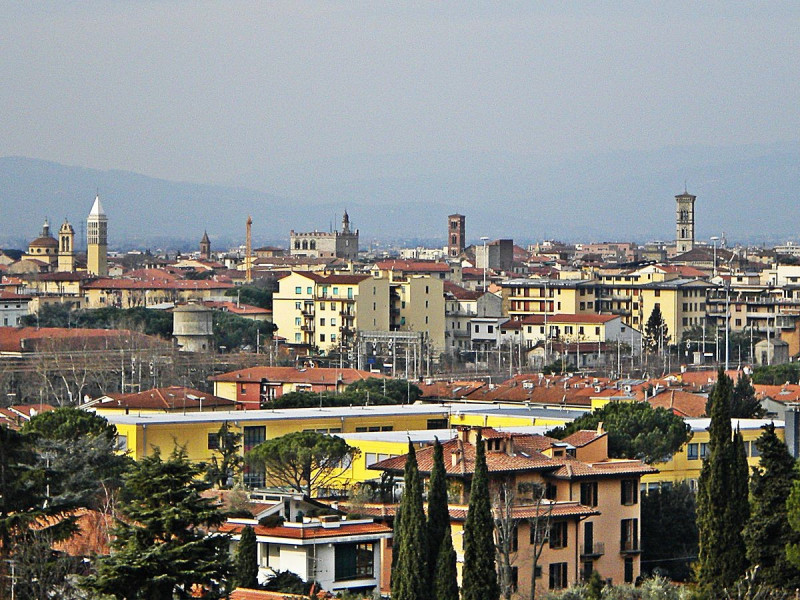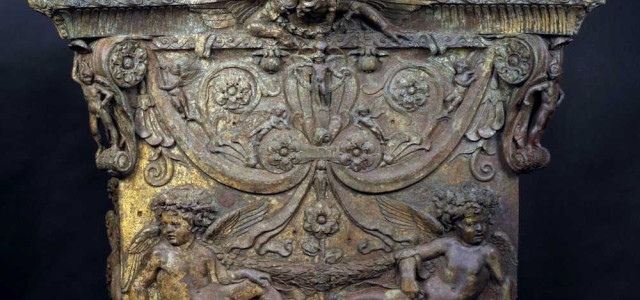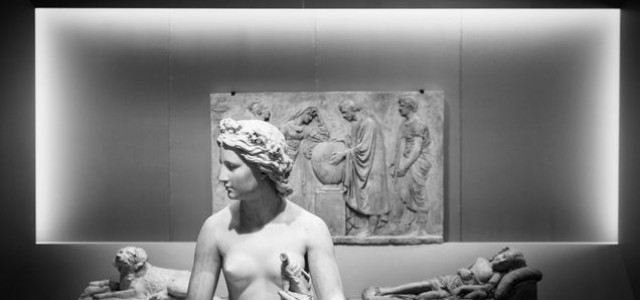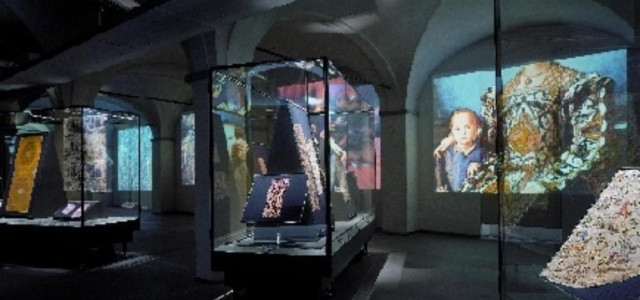Prato
Prato (Italian pronunciation: [ˈpraːto] ( ), local pronunciation: [ˈpraː(h)o]) is a city and comune in Tuscany, Italy, the capital of the Province of Prato. The city is at the foot of Monte Retaia, elevation 768 metres (2,520 ft), the last peak in the Calvana chain. The lowest elevation in the comune is 32 metres (105 ft), near the Cascine di Tavola, and the highest is the peak of Monte Cantagrillo at 818 metres (2,684 ft). The Bisenzio River, a tributary of the Arno, flows through it. Historically, Prato's economy has been based on the textile industry. The renowned Datini archives are a significant collection of late medieval documents concerning economic and trade history, produced between 1363 and 1410. The Textile Museum also reflects this history. Prato is also a centre of the slow food movement, with many local specialities, including cantucci, a type of biscotti, sold by local speciality bakers. Since the late 1950s, the city has experienced significant immigration, firstly from southern Italy, then from other nationalities, the most notable being a large Chinese community which first arrived in the late 1980s. With more than 189,000 inhabitants, Prato is Tuscany's second largest city and the third largest in Central Italy, after Rome and Florence. History Ancient age Archaeological findings have proved that Prato's surrounding hills were inhabited since Paleolithic times. The plain was later colonized by the Etruscans. In 1998 remains of a previously unknown city from that civilization were discovered in the neighbourhood, at Gonfienti (Prato) near Campi Bisenzio: it was of medium size and it was already a centre for wool and textile industry. According to some scholars, it could be the mythical Camars. The Etruscan city was inhabited until the 5th century BC, when, for undisclosed reasons, it decayed; control of the area was later shifted to the Romans, who had their Via Cassia pass from here, but did not build any settlement. Middle Ages In the early Middle Ages the Byzantine and Lombard dominations followed. The history of Prato itself begins from the 10th century, when two distinct villages, Borgo al Cornio and Castrum Prati (Prato's Castle), are known. In the following century the two settlements were united under the lords of the castle, the Alberti family, who received the imperial title of Counts of Prato. In the same period the plain was dried and a hydraulic system regulating and exploiting the waters of the Bisenzio River was created to feed the gualchierae (pre-industrial textile machines). After a siege in 1107 by the troops of Matilde of Canossa, the Alberti retreated to their family fortresses in the Bisenzio Valley: Prato could therefore develop as a free commune. Within two centuries it reached the number of 15,000 inhabitants, spurred in by the flourishing textile industry and by the presence of the Holy Belt relic. Two new lines of walls had to be built in the mid-12th century and, respectively, from the early 14th century. In 1326, in order to counter the expansionism of Florence, Prato submitted voluntarily under the seigniory of Robert of Anjou, King of Naples. However, on 23 February 1351 Joanna I of Naples sold the city to Florence in exchange of 17,500 golden florins. Prato's history therefore followed that of the former in the following centuries. Modern age In 1512, during the War of the Holy League, the city was sacked by Spanish troops assembled by Pope Julius II and the king of Aragón, Ferdinand II, to recover the nearby city of Florence for the Medici family. The severity of the sack of Prato led to the surrender of the Florentine Republic, and to the restoration of the Medici rule. Historians debate the actual number of people killed during the sack, but contemporary chroniclers asserted between 2000 and 6000 people were slaughtered in the streets. In 1653 Prato obtained the status of city and became seat of a Catholic diocese. The city was embellished in particular during the 18th century. After the unification of Italy in the 19th century, Prato became a primary industrial centre, especially in the textile sector (Italian historian Emanuele Repetti described it as the "Italian Manchester"), and population grew up to 50,000 in 1901 and to 180,000 in 2001. The town experienced a significant internal immigration. Previously part of the province of Florence, in 1992 Prato became the capital of the eponymous province. Chinese immigration The city of Prato has the second largest Chinese immigrant population in Italy (after Milan with Italy's largest Chinatown). Legal Chinese residents in Prato on 31 December 2008 were 9,927. Local authorities estimate the number of Chinese citizens living in Prato to be around 45,000, illegal immigrants included. Most overseas Chinese come from the city of Wenzhou in the province of Zhejiang, some of them having moved from Chinatown in Paris. The first Chinese people came to Prato in the early 1990s. The majority of Chinese work in 3,500 workshops in the garment industry and ready-to-wear. Chinatown is located in the west part of the city, spreading to Porta Pistoiese in the historical centre. The local Chamber of Commerce registered over 3,100 Chinese businesses by September 2008. Most of them are located in an industrial park named Macrolotto di Iolo. Raids on factories employing illegal immigrants in 2010 highlighted problems with the growth of an apparel industry in Prato based on cheap, and sometimes illegal, labor. Main sights Prato is home to many museums and other cultural monuments, including the Filippo Lippi frescoes in the Cathedral of Santo Stefano, recently restored. The Cathedral has an external pulpit by Donatello and Michelozzo, built and still used for the display of the cathedral's famous relic of the Virgin Mary, the Girdle of Thomas (Sacra Cintola, a cord belt), which had a great reputation in the late Middle Ages and is often shown in Florentine art. Also of interest is the Teatro Metastasio, the city's main venue for operas and other theatrical productions, which was built in 1829–30. Palazzi (Palaces) and Castelli (Castles) Palazzo Pretorio: The palace was begun in the 13th century in red bricks; late-gothic style additions were in white stone. The external staircase and clock were added in the 16th century and later. Palazzo Datini: Palace built from 1383 for the merchant Francesco Datini, which was decorated by Florentine artists like Agnolo Gaddi and Niccolò Gerini. In 1409 it housed Pope Alexander V and Louis of Anjou. Palazzo degli Alberti (13th century) houses a museum with works by Filippo Lippi (Madonna del Ceppo), Giovanni Bellini (Crucifix with Jew Cemetery) and Caravaggio (The Crowning with Thorns). Castello dell'Imperatore: This is the northernmost castle built by Frederick II of Hohenstaufen in Italy. Centro per l'arte contemporanea Luigi Pecci: This museum and education centre sponsors contemporary art works and exhibitions. Churches Santa Maria delle Carceri, commissioned by Lorenzo de' Medici to Giuliano da Sangallo in 1484. It is on a Greek cross plan, inspired by Brunelleschi's Pazzi Chapel. Works lasted for some twenty years. The interior is run by a bichromatic maiolica frieze by Luca della Robbia, also author of four tondos depicting the four Evangelists in the cupola. The external façade is unfinished, only the western part being completed in the 19th century according to Sangallo's design. Sant'Agostino, built from 1440 over an existing edifice from 1271. It has a simple façade with a rose window and a bell tower with pyramidal top. The interior is on the basilica plan, with a nave and two aisles divided by brickwork columns having "waterleave" capitals (c. 1410). The apse chapels date to the late 14th century. The interior is home to canvasses by Giovanni Battista Naldini, Lorenzo Lippi, l'Empoli, Giovanni Bizzelli and others, as well as 14th-century frescoes. The cloister dates to the 16th century. San Domenico (begun in 1281), with a portal from 1310. San Francesco (1281–1331). It houses a funerary monument of Geminiano Inghirami (died 1460), and the frescoes by Niccolò Gerini in the Migliorati Chapel. San Fabiano, already existing in 1082. It houses precious traces of a pavement mosaic dating from the 9th-11th centuries. Also notable is the 15th-century bell tower. Minor Basilica of Santi Vicenzo e Caterina de' Ricci, adjacent to the late-Baroque monastery of San Vicenzo. The church was decorated for the canonization of the Saint Catherine of Ricci, who was associated with the monastery and is buried in the church. Santa Maria della Pietà, built in 1617–19. It houses a canvas by Mario Balassi (1638) and a 14th-century fresco of the Madonna with Child, with alleged miraculous powers. Sport Rugby Club I Cavalieri Prato A.C. Prato Primavera Prato Education Higher-education institutions include Il Polo Universitario "Città di Prato" (a branch of the Università degli Studi di Firenze) and the Monash University Centre which is located in the Palazzo Vai. The University of New Haven opened a satellite campus in Prato in 2012. Notable citizens International relations Prato is twinned with: See also The Crowning with Thorns (Prato) References External links Culture in Prato Exhibition Da Donatello a Lippi. Officina Pratese at Museo Civico di Palazzo Pretorio in Prato (September 2013 - January 2014) Information about Prato, Free Time Guide on Prato (Italian) Complete Image galleries of the town, the medieval historic centre, churches and the Chinese quarter (Italian) Chinese Remake the 'Made in Italy' Fashion Label A City Transformed - slideshow by The New York Times http://www.britannica.com/EBchecked/topic/474045/Prato






